I’ve dealt with a lot of different colored weeds over the years but weeds topped with white flowers were not something I was expecting to crop up on my lawn.
Identifying these weeds will help you determine the right control methods including herbicides and pesticides.
Even though there are more than 15 weeds with white flowers, here’s a list of the most common unwanted plants that includes:
- White clover
- Common chickweed
- Fleabane
- Quick weed
- Wild carrot
You may also be interested in identifying yellow flower weeds or purple flower weeds.
15 Most Common Weeds With White Flowers
I’ve listed these weeds in order of the likeliness of the weed appearing in your yard. This will vary depending on your growing region.
To make things easy, you can jump to the section you are interested in using the links below:
- Dandelions (Traxacum)
- White Clover (Trifolium repens)
- Hairy Bittercress (Cadamine hirsuta)
- Meadow Death Camas (Zygadenus venenosus)
- Bindweed (Convolvulus arvensis)
- Daisy Weeds (Bellis perennis)
- Creeping Speedwell (Veronica filiformis)
- Common Chickweed (Stellaria media)
- Fleabane (Erigeron annus)
- Queen Anne’s Lace (Daucus carota)
- Jimson Weed (Datura stramonium)
- Nettle (Urtica dioica)
- Mouse-ear Chickweed (Cerastium)
- Quickweed (Galinsoga parviflora)
- Wild Carrot (Daucus carota)
#1. Dandelions (Traxacum)
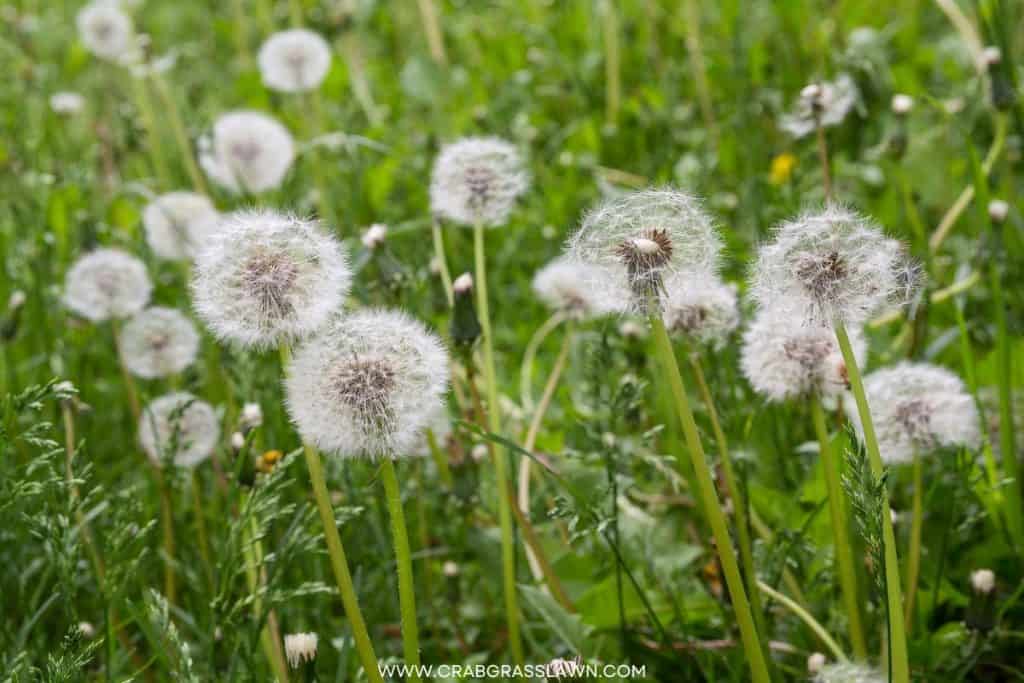
As you are probably aware, Dandelions start off yellow, but their flower turns into a white ball after a few days.
Dandelions have the capability of growing over 16 inches feet tall. Dandelions can be found in most areas and places in North America including lawns and other open grassy places such as fields and roadsides.
To remove: This common lawn weed can be pulled by hand, or using a daisy grubber, but if the area is infested, broadleaf herbicides or post-emergent herbicides work well to eliminate this broadleaf weed. You may want to choose a Dandelion killer that won’t kill your grass.
#2. White Clover (Trifolium repens)
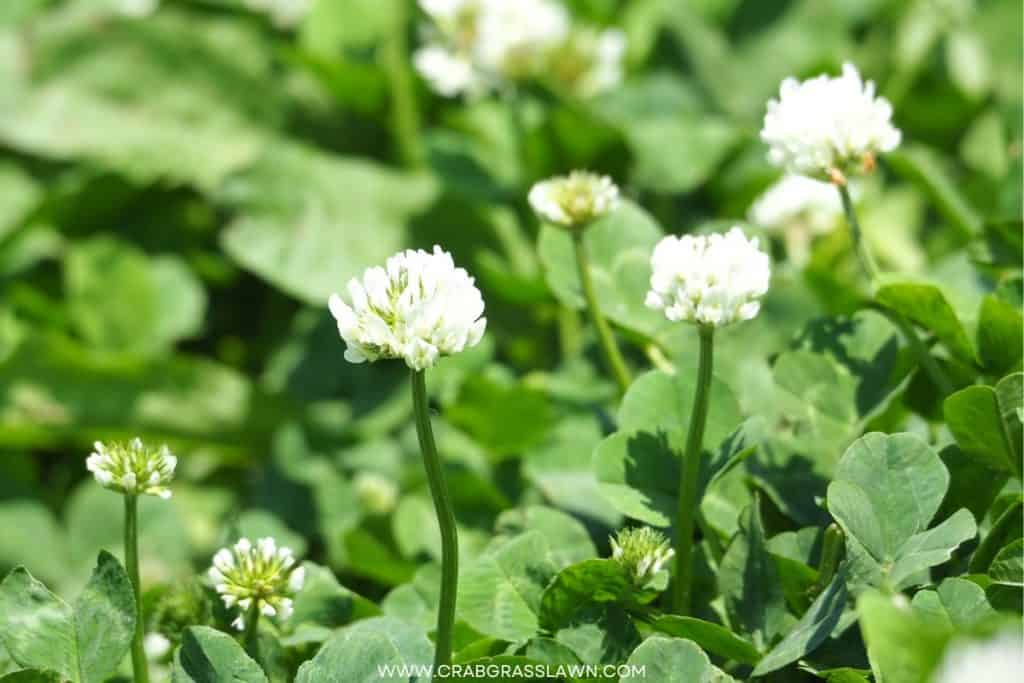
White clover is a perennial weed that grows to about four inches tall and, through its creeping stems, can grow to over a foot wide. This plant Prefers moist soils in light shade but will tolerate full sun and dryish soils. The plant has a small bushy white flower on it.
To remove: Good news for those who are looking for natural ways to kill weeds! White clover is particularly easy to kill by applying vinegar to it. A chemical approach is also effective in removing ground clover.
#3. Hairy Bittercress (Cadamine hirsuta)
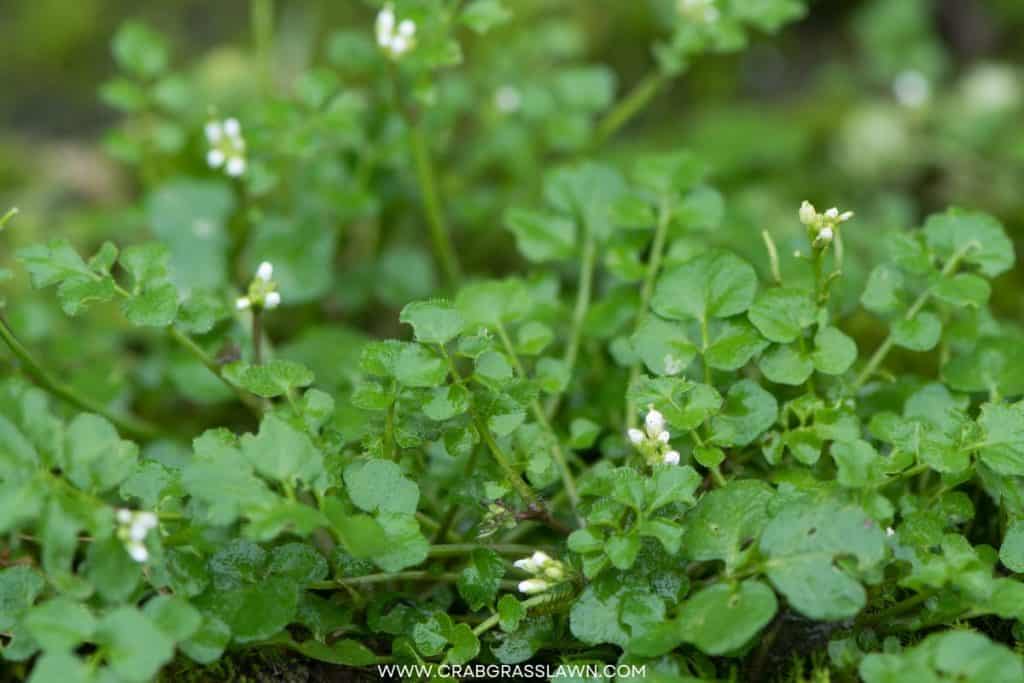
This fast-growing member of the mustard family has tiny white flowers that bloom from April well into May. Bittercress flowers turn into seed pods that create seeds that are most commonly transported to a new location by the wind.
To remove: Most of the time, pulling Hairy Bittercress will result in you pulling the hairy stem and leaves but leaving the tap root behind. This will just cause the plant to regrow again. If you choose to remove by hand, use a daisy grubber or small shovel to make sure you remove the entire plant.
#4. Meadow Death Camas (Zygadenus venenosus)

Meadow Death Camas has tiny white flowers with a yellow center that form a pyramid-like shape. While attractive, this plant is poisonous. Meadow Death Camas prefers warm, dry climates and blooms April to July.
To remove: Due to the toxicity of this plant, hand removal is not recommended. Use a natural or chemical herbicide to spray this plant.
#5. Bindweed (Convolvulus arvensis)
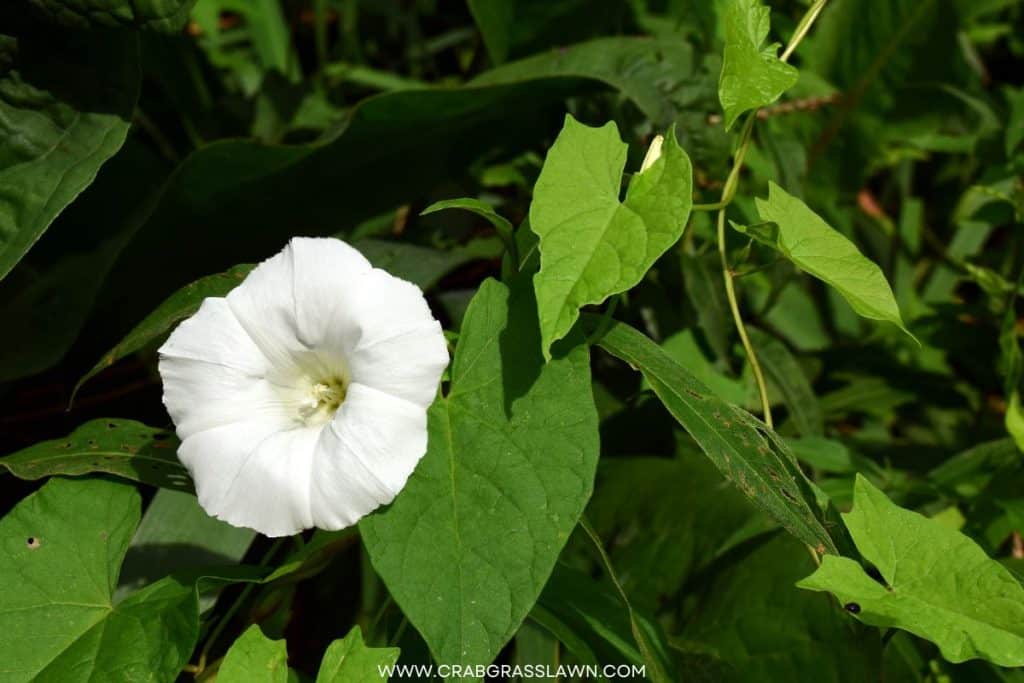
Bindweeds- This weed is my archnemesis. This plant will have white or white and pink flowers in summer to early fall. Its long vines wrap around, grow up, through, and over anything that gets in its way. It is an aggressive plant that can overtake other flowering plants around it.
To remove: Bindweed plants can be controlled by spraying with broadleaf herbicides or non-selective herbicides. Hand-pulling the entire plant as soon as you see it can help it from quickly spreading.
#6. Daisy Weeds (Bellis perennis)
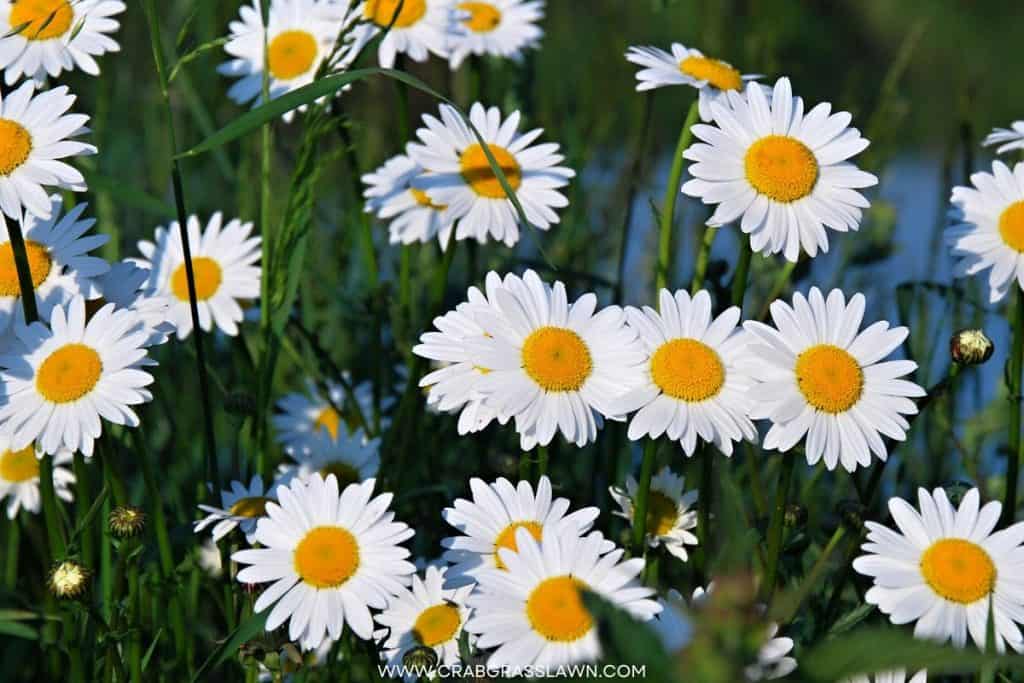
Daisy weed is an attractive flower when it’s located in the correct location in your garden, but it can quickly become nothing more than a flowering weed if not controlled. It has a yellow-centered flower surrounded by white petals that is between an inch or two inches in diameter and prefers moist, fertile soils.
To remove: When they start to grow in unwanted areas, hand-pulling plants keep them from spreading wildly. Pre-emergent herbicides in the spring will keep the plant from growing in most places.
#7. Creeping Speedwell (Veronica filiformis)
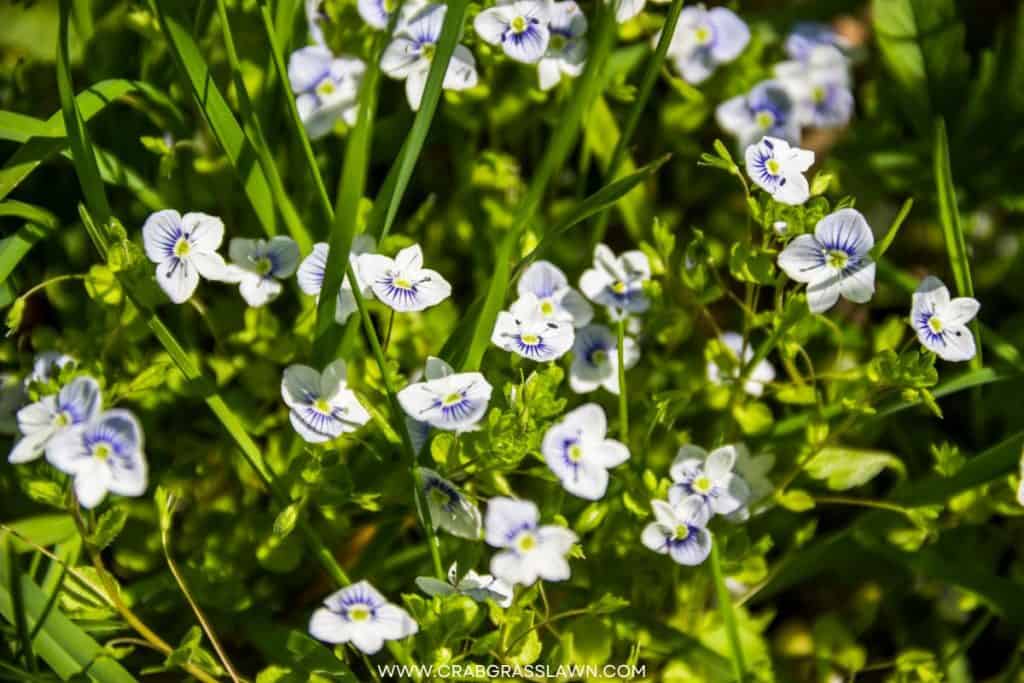
Creeping Speedwell is an attractive-looking plant that many uses as a groundcover. It can quickly spread, creating problems. Creeping Speedwell has white or blue flowers that bloom from Spring to late summer and small green leaves. The plant grows two to three inches tall and prefers fertile soil but will sometimes grow in poor-quality soil as well.
To remove: Hand-pulling these pants can be done, but it’s difficult. Start by raking over the area and pulling the runners, then dig up the underground stems and roots. Use a post-emergent broadleaf herbicide if you don’t want to go the manual route.
#8. Common Chickweed (Stellaria media)
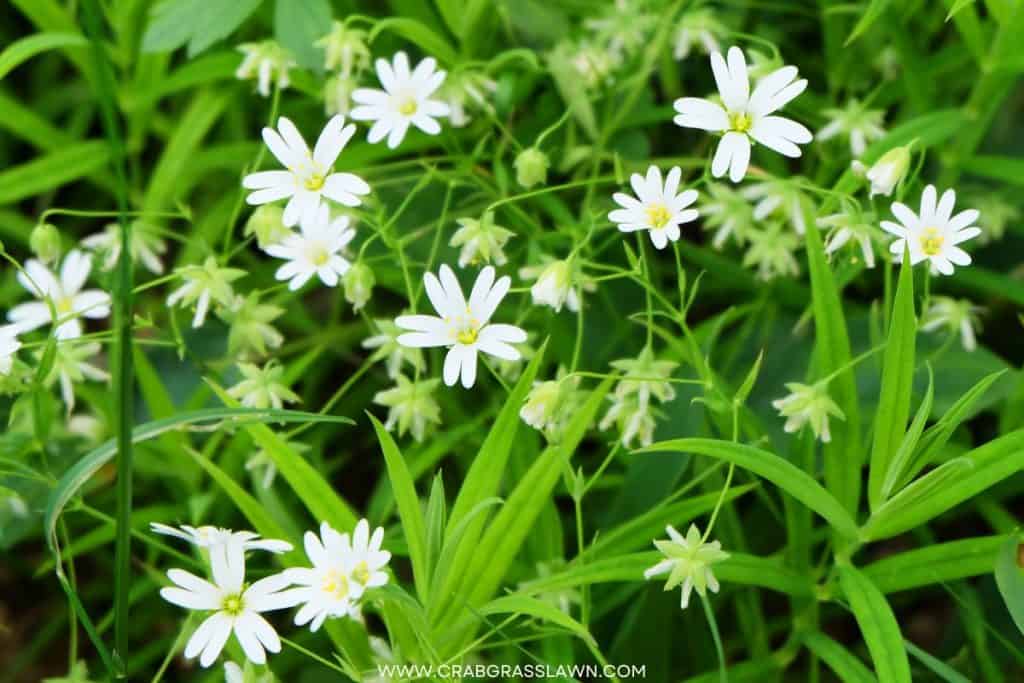
Chickweed is an annual weed with tiny white flowers. Chickweed grows well in moist soil and partial shade.
To remove: Using a preemergence herbicide in the early spring before the plant flowers will help eliminate this pesky weed.
#9. Fleabane (Erigeron annus)
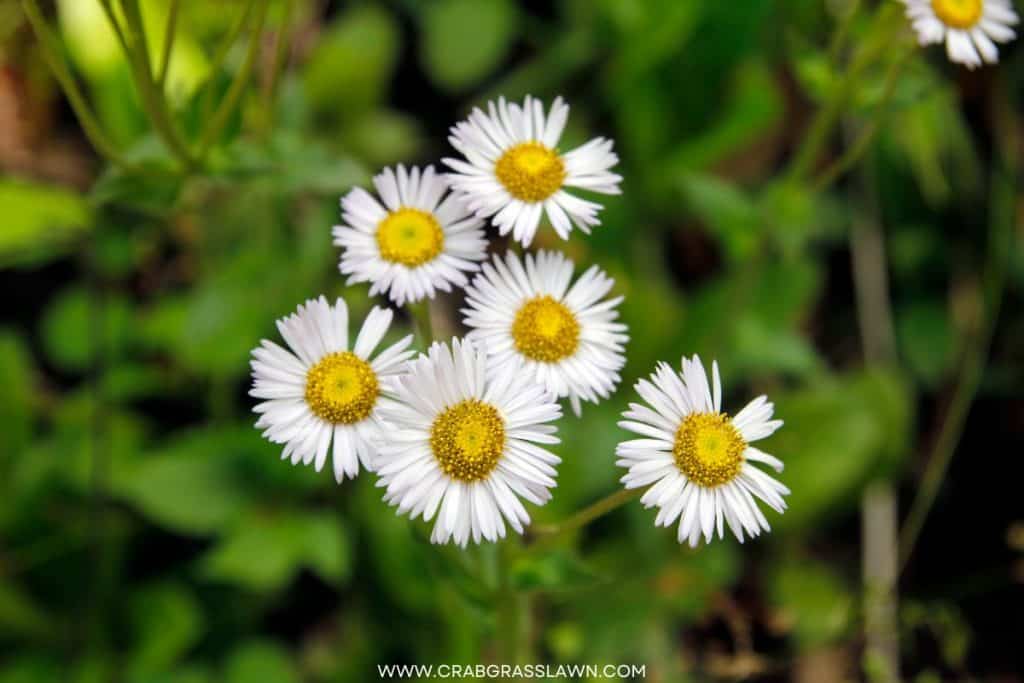
This daisy lookalike has tiny stalks that grow from a fibrous root system. The yellow-centered flower with white petals grows best in sunny open spaces.
To remove: For a smaller-sized plant, it can grow pretty deep roots, so be prepared to do some digging if you are going to remove by hand instead of using a chemical method.
#10. Queen Anne’s Lace (Daucus carota)
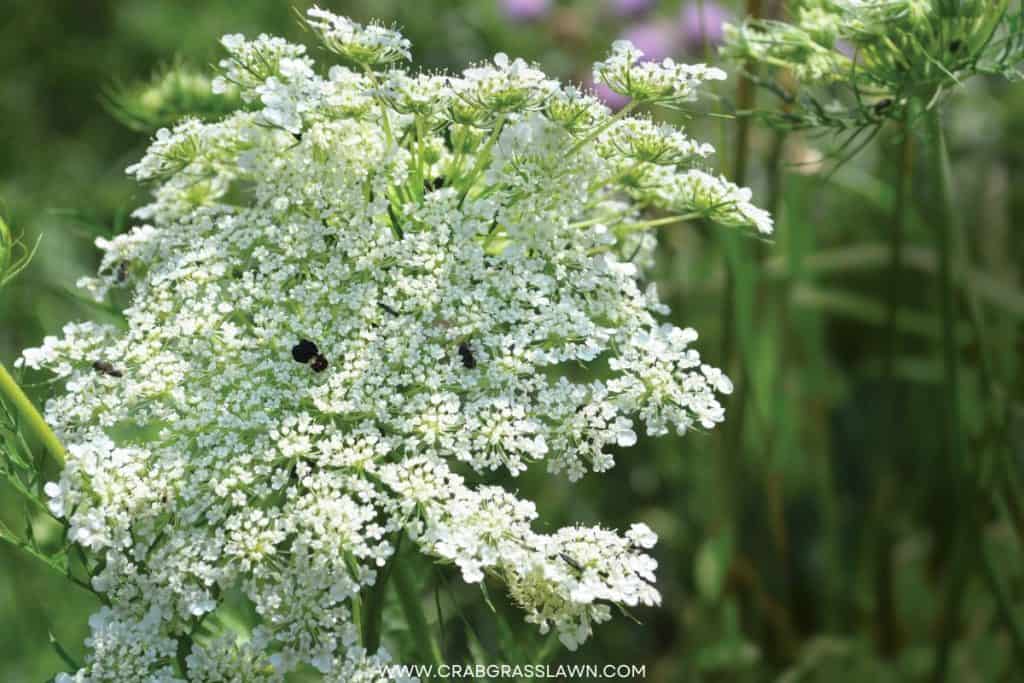
This plant gets its name from the flowers that group together at its stem and create a lace-like appearance. Queen Anne’s Lace can grow up to four feet tall. It will grow in just about any soil but prefers well-drained soil in sunny spaces.
To remove: In most cases, Queen Anne’s Lace can easily be pulled from the ground by hand. Be sure to dig the entire plant up and dispose of it properly.
#11. Jimson Weed (Datura stramonium)

Jimson Weed produces white flowers that look a little like the Bindweed. Like other members of the nightshade family, this plant flowers at night. Jimson weed will grow in almost any soil type.
To remove: Hand pulling or applying selective broadleaf herbicides will provide good control of this Jimson Weed.
#12. Nettle (Urtica dioica)

This perennial plant produces flowers that may be white or green that will turn brown pretty quickly after blooming. Nettle leaves have a lot of small hair fibers. Some nettle species can be toxic. Nettle grows well in soil that is rich in nitrogen.
To remove: Broadleaf weed killers do well when used to eliminate this ground weed. If you choose to hand-pull, be sure to wear gloves and eye protection since many Nettle species are toxic.
#13. Mouse-ear Chickweed (Cerastium)

Mouse-Ear Chickweed is a broadleaf weed that normally acts as a perennial and has flowers that have 5 sepals that are nearly as long as its white flower. The stalks are thin and hairy. Flowers bloom from May to September and later turn into small seed heads.
To remove: Since Mouse-ear chickweed is a perennial weed, a broadleaf herbicide will yield the best results in removing this plant.
#14. Quickweed (Galinsoga parviflora)
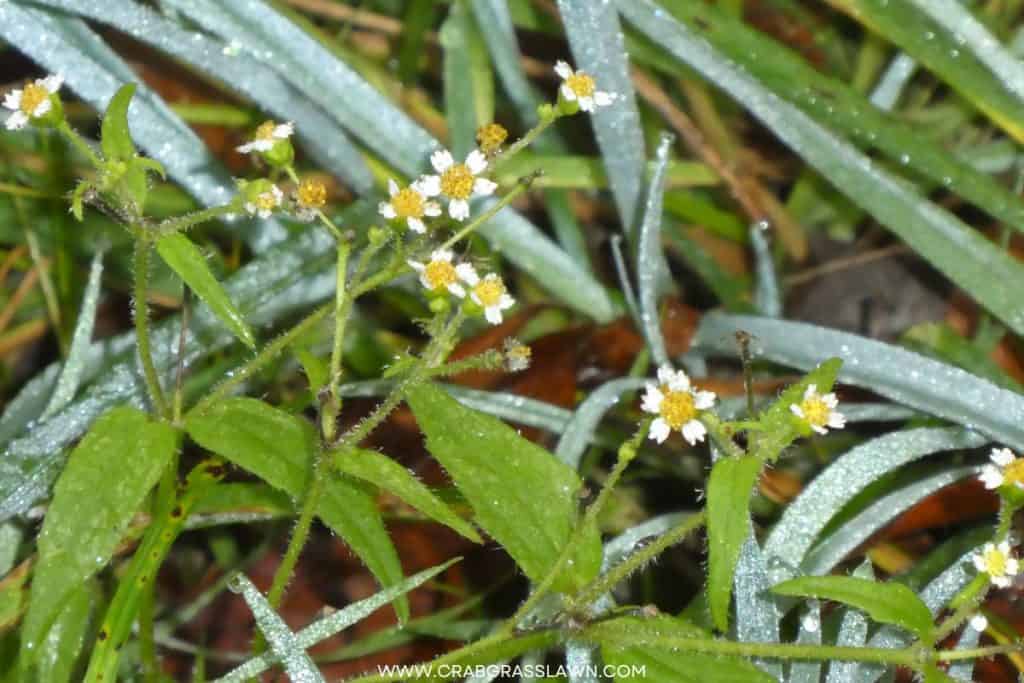
You likely wouldn’t have guessed that this plant is actually a member of the sunflower appearance after glancing at it. This plant boasts a small, white five-peteled flower with a white center. Quick weed has a shallow root system but can spread many feet wide rather quickly, especially in sunny, north-facing locations.
To remove: Quickweed can be especially problematic for farmers as it can become invasive in their growing crops and desirable grass areas. Hand-pulling this weed can be easy if you only have a few plants. For areas that have become infested, use a herbicide to eliminate Quickweed.
#15. Wild Carrot (Daucus carota)
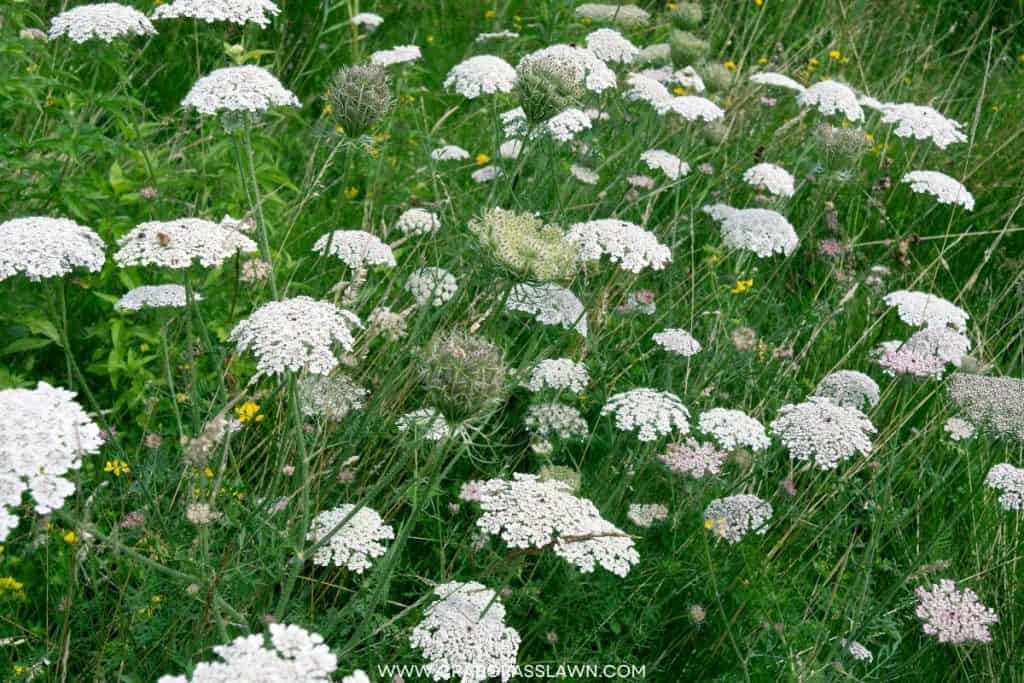
Before you grab some wild carrots thinking it will make a great snack, take caution! It looks a lot like the poisonous hemlock plant! You should probably just stick to getting your garden carrots at the farmer’s market. Wild carrots like to grow in disturbed areas. This non-native plant has broad leaves that are busy and small white flowers.
To remove: Small patches can be controlled manually by digging and removing the tap roots. Be sure to dispose of the entire plant, and don’t drop any seeds. If you get Wild carrots in your lawn, mowing can effectively keep the plant from reseeding. Large spots can be controlled with herbicide applications.
FAQs about White Flower Weeds
Q: What are the weeds with white flowers called?
A: There are a lot of weeds that have white flowers. Like all other weeds, they can grow many feet wide and many feet deep, and their flowers can be less than an inch wide to many inches wide. Use the table to help determine which weed type you have grown and how to remove it.
Q: Are those little white flowers weeds?
A: If you have weeds with small yellow flowers on your lawn or other turf grass, it is likely white clover, chickweed, daisy weeds, or hairy bittercress.
Q: Are there weeds that look like daisies?
A: Daisy weeds, and fleabane both produce small flowers that look like the daisy you’d want to plant in a garden or plant box.
Q: What weed looks like a flower?
A: I get this question a lot, is it a weed or a flower? It’s a flower if it produces a flower and is growing in places like a flower bed where you want it to grow. It’s a weed if it’s growing where you don’t want it, even if it produces a pretty flower.
Q: What are the most common garden weeds?
A: This answer will ultimately depend on where you live. The table provided is ranked by the plants most likely growing in most regions of North America. It may be different depending on the region that you live in.
Q: What if I don’t want to use chemicals to remove weeds?
A: As gardeners become more environmentally conscious, natural remedies for removing weeds are becoming more common. Tools like daisy grubbers sharply pointed shovels, and spades are great for removing lawns. Natural weed killers, including dish soap, vinegar, and salt, can effectively remove many weed types.
Q: Are white flowers weeds easy to remove?
A: This really depends on what type of weed it is, the condition of your soil, and how much of the weed you have growing. Often times these plants will produce hundreds of seeds, so you will pull some out, and a few weeks later, they will be back growing again. Other times a simple pull will do the trick.
Q: Are there any precautions I should take to pull white flower weeds?
A: The quick answer is yes! Some of these plants are toxic. You will want to either avoid pulling them by hand or ensure your skin and eyes are covered when you remove them. You should also check for other plants like poison ivy lingering among your other weeds.
Final Thoughts
The best way to keep white flower weeds at bay is early prevention. Apply a preemergence herbicide early in the spring to prevent weeds from growing.
Monitor your garden and lawn regularly. White-flowered weeds will often grow extensive weed systems in rich soils you are trying to grow grass or other flowers and garden plants.
Once weeds with white flowers start to grow in places like healthy lawns and flower beds, try to remove them by hand. This will save you some money. If you have nuisance weed growing out of control, consider using a broadleaf or post-emergent herbicide.
Hi, Alex Kuritz here. Growing up I remember that my family had one of the best lawns in the neighborhood. Richly green and lush. I did a lot as I grew up in terms of caring and tending for not only my family’s lawn but also my neighbors. I can say I have years of experience, and I am here to share it with you.


